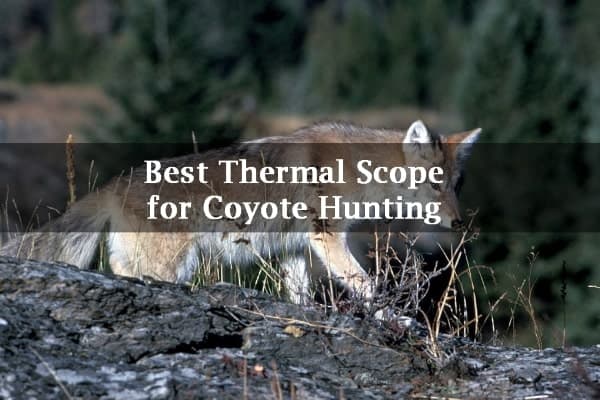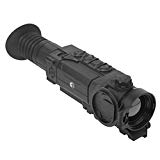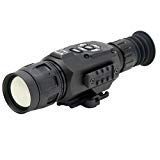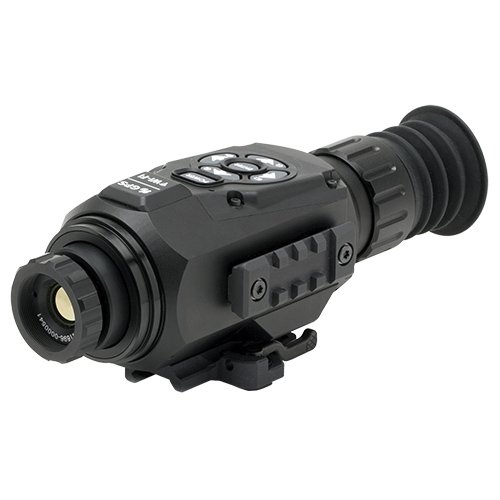Best Thermal Scope for Coyote Hunting Reviews 2021
Our experts like to share product recommendations with you and hope you like them! Just to make you aware, CatchThemEasy may collect a small share of sales or other compensation from the links on this page.

So you’re looking to take your day and nighttime coyote hunting game to the next level huh? In that case, you should definitely be looking for a top thermal scope for hunting those coyotes. Choosing a good one shouldn’t be too hard – there’s more options out there than you could ever need. One thing for sure is that a good thermal scope will not be cheap. But, a thermal scope will let you see your target (provided, you know, it’s warm – like a coyote) clearly at night, perhaps even better than night vision.
Get your predator shooting sticks and rifle ready, as we show you our take on the best thermal scopes for coyote hunting.
Top 5 Rated Models Comparison Table
Image | Thermal Scope | Resolution | Magnification | Price |
|---|---|---|---|---|
Editors Choice | 640x480 | 3-24x | ||
324x288 | 10x | |||
640x480 | 10x | |||
336x256 | 3-12x | |||
384x288 | 32x |
Reviews of The Best Thermal Scopes for Coyote Hunting
The first, and most expensive thermal scope, we’re looking at is the Armasight Zeus 640, boasting a 640x512 sensor (with 17-micron pixel size) and a 75mm lens. Optical magnification is 3x, while digital zoom goes up to 8x, for a total of 3x-24x. The refresh rate is a quick 60hz.
The Zeus’ body is made from CNC’ed aluminum alloy, sturdy and quality, as you would hopefully expect from a scope in this price range. It’s water and fog-resistant, too. There’s a whole host of features, too; a wireless remote control, an onboard video recorder without output port, various color modes (white hot, black hot, rainbow, etc) as well as 6 reticle patterns (DoT 4 MOA, Line Dot, etc). And it sits on top a Picatinny Rail mount for quick mounting on any rifle.
The biggest con to this scope is just how expensive it is – similar to the price of a used car. You do get a high-quality scope with lots of features, but whether it’s worth spending that much money is up for debate.
Otherwise, this is one tank of a scope. Large lens, bright, a variety of modes, video output – there’s almost nothing it can’t do. And it comes with a 3-year warranty.
Pros
- Large sensor size
- 24x zoom possible
- Sturdy, waterproof, CNC-aluminum body
- Internal video recorder
- 6 reticle patterns
Cons
- Huge
- Very expensive
Verdict: Best Overall
The Pulsar Trail XQ is a smaller scope than most others on our list, with a 324x288 sensor, 640x480 AMOLED display, and 50mm lens. Zoom goes from 2.7x to 10x, and boasts a refresh rate of 50hz – not as much as the Armasight Zeus, but still decently fast. The range is up to 1800 yards, and the Trail XQ has 13 electronic reticles to choose from, as well as a one-shot zeroing function.
The body is IPX7 waterproof and dust-resistant, the battery lasts 8 hours, and the body is relatively compact compared to some other thermal scopes. Like the Zeus, it has an integrated HD video recorder, and a picture-in-picture mode, which gives you a magnified image of the reticle area at the top of the screen, for an even more accurate shot. If you’d like to, you can hook it up via WiFi to your smartphone, and actually stream footage from the scope to the app. Fancy. And, Pulsar designed it to withstand recoil up to a .375-cal.
Our only wish for the Trail XQ is that the battery might last longer; 8 hours, while not bad, isn’t necessarily long enough for a whole day or night in the field, and it would be a pain to change the battery out multiple times over a long hunting trip.
Overall, the Trail XQ is a worthy scope in a middle price range, that can compete with most other scopes. It boasts plenty of magnification in a sturdy package, and the video streaming is pretty cool.
Pros
- Good price
- 10x zoom
- 50hz refresh rate
- IPX7 waterproof/dust resistant
- HD Video Recorder, Live streaming with Wi-Fi
Cons
- The battery could last longer
The ATN ThOR HD 640 is another excellent scope at a good price. It has a 640x480 sensor with 10x magnification, and boasts a built-in rangefinder, which makes calculating the distance to your target an getting a perfect shot super easy, cutting down on both time and effort, and reducing the amount of gear you need to carry with you. It also has a ballistic calculator, which lets you estimate your bullet’s trajectory and see exactly where it will hit. Combine the two and you have one accurate scope for the toughest of shots.
The ThOR HD features HD video recording, like some other scopes. But a cool feature it has, that others don’t, is Recoil Activated Video, which starts recording as soon as you shoot – pretty cool. It also has WiFi streaming to your phone, letting you use your device as a viewfinder if you see fit.
A few things to keep in mind; the image is a bit grainy, especially compared to other thermal scopes in the same price range, which are clearer. And certain knobs tend to stick and not function properly; there are some quality-control issues. Which is frustrating when you’re spending this much money on a scope.
However, if you’d like a scope with a large sensor size at a lower price, the ThOR HD 640 is a good choice.
Pros
- HD Video Streaming
- Recoil Activated Video
- Large Sensor Size
- Ballistic Calculator + Built-in Rangefinder
Cons
- QC issues
- Grainy image
The smaller version of the Zeus above, the Zeus 336 boasts a smaller sensor size of 336×256, with the same refresh rate of 60hz, and an 800x600 display size. Zoom goes up to 12x. And it has the same various color mods, 6 different reticle patterns, and a bunch of “Imaging Filter Algorithms” – Active Contrast Enhancement, Digital Detail Enhancement, and Automatic Gain Control, to name a few.
The body is also made from CNC’ed aluminum alloy, is fog proof and water-resistant. It also has wireless remote control, video recording with output, and attaches to a rifle with a standard MIL -STD-1913 rail mount. It also has rails on the unit itself, for attaching day optics or other accessories.
One problem: despite the otherwise sturdy build, there have been complaints of the lens cracking from recoil, even on smaller rifles (.223). This is, needless to say, disappointing.
But, if you’d like the features of the Armasight Zeus but can’t spend twice the money, and don’t need as large a sensor, the Zeus 336 is a cheaper alternative.
Pros
- CNC’ed Aluminum Alloy Build
- 336x256 sensor size
- 3-12x zoom
- 60hz Refresh Rate
- 800x600 AMOLED display
Cons
- Has cracked on recoil
The ATN ThOR HD 384 is, like the Zeus 336 to the Zeus 640, the smaller version of the ThOr HD 640. It boasts a smaller sensor of 384x288, with a zoom range of 1.25x-5x. It has the same Ballistic Calculator and Rangefinder, as well as HD video recorder (shooting up to 1080P video) and Recoil Activated Video, paired with WiFi capability so you can stream everything to your phone if you like.
The best part of the ThOR HD 384? It’s half the price of other scopes, even quarter. It’s the least-expensive scope on our list.
The only problem with that, of course, is that the quality is just not as good as it could be; some people have received scopes that don’t turn on, the dials might get stuck, and the company doesn’t offer good customer support.
But, if you’re on a budget and still want a decent scope with WiFi and video recording, the ThOR HD 384 should get the job done.
Pros
- Affordable
- 1.25x-5x zoom
- Records HD Video. 1080P.
- WiFi For Video Streaming
- Ballistic Calculator + Rangefinder
Cons
- Quality issues
- Poor Customer Service
What to Look For In A Good Coyote Hunting Thermal Scope
Magnification
The first thing you want to look out for when choosing a thermal scope? What kind of magnification does the scope offer? How much magnification you need will depend on the kind of shooting you do, and from what range. Generally, you’ll want something at least 4x-6x, but you can get scopes that go anywhere from 10x-32x by combining digital and optical zoom. 32x is probably a bit overkill for most shooters; anywhere from 4x-10x will work fine.
Size
Whenever possible, get the smallest, lightest, most compact scope you can find. You really don’t want to be lugging around any unnecessary weight, especially on long days or nights in the outdoors. Heavy scopes can really drag you down, so choose one no more than 4 or 5 pounds and make sure it fits onto your rifle without being too bulky. Size usually correlates with magnification and objective size; a large objective and large magnification often mean a large scope, which can become cumbersome and is often unnecessary.
Objective Size
Objective size is different from magnification or resolution; it is the actual physical size of the lens objective – the inside diameter of the objective lens frame. The larger the objective lens, the more light can pass through the scope and the brighter and clearer your image will be. So if you like shooting in dim conditions – early morning and dusk – a scope large objective size might be in order. Just don’t get one too big; a scope too large for your bore can make aiming accurately at close range more difficult. And of course, the larger the scope, the heavier and more unwieldy it can be – which leads us to our next point.

Refresh Rate
Refresh rates pertain to a scope’s thermal abilities; it’s a count of how many cycles per second the scope is capable of – how fast the image refreshes itself. So a 30hz refreshes itself 30 times a second, while a 60hz refreshes itself 60 times a second. The faster the refresh rate, the smoother and more lifelike the image is; choose one with a refresh rate of at least 30hz for useable images, but 50hz or 60hz is even better and makes for even better images. Some high-end but expensive scopes might have even faster refresh rates.
Resolution
You need to pay attention to the resolution your scope offers. The higher the resolution, the clearer and sharper the image will be. And the sharper the image, the easier it will be to make out the target and line up a shot. Higher resolution also lets you zoom in on the target more without sacrificing image clarity and quality.
The tradeoff of opting for a large resolution of course, is cost; a 640x480 scope can easily be twice as expensive as a 384x288. So find one that fits your budget without sacrificing quality.
Battery Life
It’s easy to forget that many thermal imaging scopes need batteries to operate; most scopes will get a battery life of 4-6 hours, but some can get up to 12. Some scopes run off regular disposable batteries while others will work with rechargeable batteries (usually CR123 batteries).
Thermal Imaging vs Night Vision for Predator Hunting
Even although both options are great at night, there are a few key differences between them that you should be aware of before purchasing one for coyote hunting.
Thermal Imaging
This is the option that we are reviewing in this article and we believe to be the best option for predator hunting. However, like anything, it has it's drawbacks also.
Thermal vision does not need any light and works by picking up heat, allowing you to pick up anything from recent footprints to moving coyote in complete pitch darkness. It's primary job is the detection of shapes from the heat, which it does a great job of detecting either at night or during the day.
The most significant off-putting factor with a thermal coyote hunting scope is the large price tag that they generally have. These options are more expensive than night vision and not in everyone's price range. Because they are also designed for detection and not identification, they lack the detail that night vision offers, though some of the higher resolution models are incredibly detailed.
Pros and Cons of Thermal
Pros
- Doesn't need light, can be used in pitch darkness
- Picks up all heat
- Great for detection
- Can be used during the day
Cons
- Expensive
- Not as detailed as night vision
Night Vision

Another great alternative for hunting predators at night that has it's pros and cons.
The one big advantage it has over thermal is that it's simply cheaper, although we're well aware that cheaper doesn't mean better. However, this does mean that more hunters will have the opportunity to buy one because of the price. Another thing that stands out over thermal imaging, is the detail it offers. Night vision is designed for recognition and identification, offering a more detailed view.
One of the biggest problems is that night vision needs light to perform, as all it typically does is amplify current light. This means that you might struggle to pickup up animals and objects against a dark background at night.
Pros and Cons of Night Vision
Pros
- Less expensive than thermal
- More detailed viewing
Cons
- Needs some light to work
- Not as good as thermal at detecting animals
Final Thoughts
If you have the money, we easily recommend the Armasight Zeus 640 as the best thermal scope for coyote hunting. Yes, it is very expensive, but for good reason. It’s a high-quality, durable scope with a large sensor, video recording, a hefty 24x zoom and a super-fast refresh rate of 60hz. It’s fogproof and water-resistant, with a CNC’ed aluminum body, and it features all the various reticles and light modes you could ask for. A serious scope for serious predator marksmen.
If you don’t have quite that much money to spend, but would still a good, quality scope, we also like the Pulsar Trail XQ. It’s half the price, and packs in up to 32x magnification and a 384x288 sensor into a waterproof, compact package.
So whether you’re looking to invest in the best scope money can buy, or just need something to get the job done, there’s a thermal scope for you.










